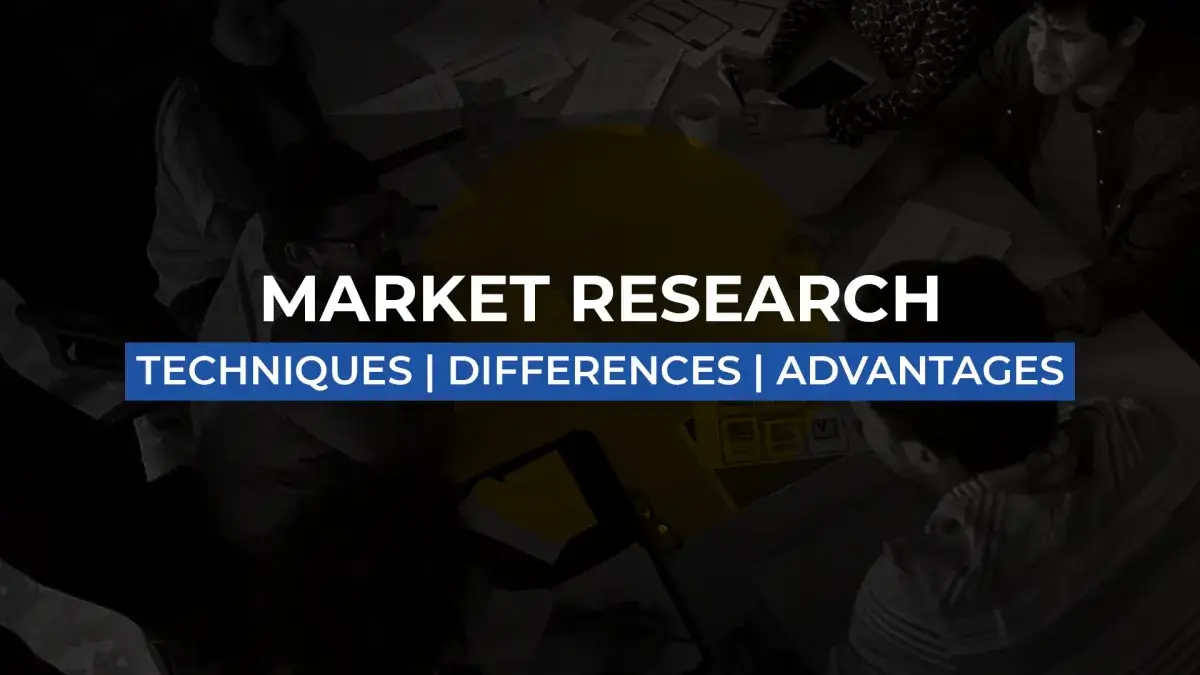Market Research | Primary and Secondary – Techniques, Differences and Advantages

Here's What We've Covered!
Have you ever wondered how some companies seem to predict exactly what their customers want and make smart decisions that keep them ahead of their competitors? Well, that’s where market research comes into picture. Market research is like a tool that businesses use to understand their customers, competitors, and the ever-changing market landscape.
So in the following blog, we’re going to enter into the thrilling world of market research and focus on its two main approaches: Primary and Secondary research.
Understanding Primary and Secondary Research
Let’s start by breaking down what primary research is all about.
Imagine that you’re like a detective, but instead of solving crimes, you’re agenda is to find information to make smart decisions for your business. Primary research is like being that detective as you’re the one going out there to gather fresh, brand-new data straight from the people who matter the most which is your target audience.
So, how does the process of “gathering original data” unfold? Think of it as conducting purpose-driven conversations. Surveys, interviews, and focus groups become your tools, each designed to extract specific information.
- This isn’t just any inquiry it’s structure to extract insights that serve as building blocks for strategic decisions.
- These insights, akin to proprietary ingredients, are exclusive to your business.
- They’re custom-made to shape your strategies, ensuring you’re meeting consumer desires with pinpoint accuracy.
You’re not just asking any old questions; you’re asking the right ones that’ll give you insights for better product/ service enhancement.
And the cool thing is, this data is like a secret ingredient. Nobody else has it as it’s exclusively for you to mix into your business strategy.
Now let’s move to Secondary research. It’s all about analyzing data and information that others have already collected, letting you discover valuable nuggets without starting from scratch.
This is how it works:
- First you gather data from a variety of sources like research papers, market reports, historical records, government publications, and more.
- Your role here is to synthesize and analyze the information because you’re not collecting the data yourself; you’re becoming a data detective and looking for insights hidden within the collected data.
- After going through the collected data, you’ll begin to see connections and eventually will draw conclusions. These conclusions can help you understand market trends, consumer behaviors, historical events, or whatever the focus of your research may be.
- The art lies in contextualizing your findings within the broader landscape. How does your data align with current industry trends? How does it contribute to understanding a societal issue? These insights add depth to your analysis.
But if Primary data gives all the data then why does Secondary Research matter?
Well, secondary research is about adding your perspective, synthesizing disparate pieces, and gaining insights that can guide decisions. Whether you’re creating a business strategy, exploring historical events, or understanding consumer preferences, secondary research equips you with the wisdom of those who’ve trodden the path before you.
So, the next time you’re diving into secondary research, remember: you’re not just an observer, you’re an interpreter of existing knowledge.
Techniques for Primary Research
In this section let’s explore the toolkit of techniques waiting to help you tap into the minds of your target audience during Primary market research. Just like a painter selects the right brush for each stroke, you can choose the perfect technique to gather data that fuels your business decisions.
- Surveys : It involves collecting standardized data by asking participants a set of predetermined questions. They are for obtaining a wide array of opinions and experiences from a larger audience.
Advantages:
-
- It is efficient for collecting data from a large group.
- It includes structured questions to ensure consistency
Suitability for Research Objectives:
-
- Gathering opinions on a wide range of topics.
- Quantitative data analysis
- Interviews: They are one-on-one conversations where researchers ask open-ended questions to understand the participants’ thoughts, experiences, and perspectives.
Advantages:
-
- In-depth insights through open-ended questions.
- Flexibility to explore unforeseen avenues
Suitability for Research Objectives:
-
- Exploring complex opinions and experiences
- Qualitative data collection
- Focus Groups: It involves a small group of participants discussing a topic under the guidance of a moderator.
Advantages:
-
- Rich discussions due to group dynamics.
- Stimulating idea generation
Suitability for Research Objectives:
-
- Exploring diverse perspectives.
- Uncovering group dynamics
- Observations: It involves directly observing participants’ behaviors in real-life settings.
Advantages:
-
- Capturing behavior in natural settings
- Non-verbal cues offer unique insights
Suitability for Research Objectives:
-
- Studying behavior and interactions
- Ethnographic research
So there you have it, a lineup of primary research techniques where each technique serves a unique purpose. Remember, this toolkit isn’t about picking just one technique you can even mix and match them for a symphony of insights that elevate your decision-making game.
Techniques for Secondary Research
Imagine you’re working with a vegan restaurant that wants to revamp its menu and marketing strategies to attract health-conscious customers. How do you plan to execute this procedure? Of course, having individual conversations with all your customers would be incredibly time-consuming. But don’t worry because in such scenarios secondary research techniques could be employed
Wondering how?
- Literature Reviews: It involves reviewing and summarizing existing studies, articles, and publications related to a specific topic.
Advantages:
-
- Access to a wide range of existing research
- Provides historical context and scholarly insights
How it complements Primary Research:
-
- Building a foundation of existing knowledge.
- Identifying gaps for primary research
- Data Analysis: Data analysis involves examining existing datasets.
Advantages:
-
- Utilizes pre-existing data for trend identification
- Offers quantitative insights and patterns
How it complements Primary Research:
-
- Validating primary research findings
- Identifying industry trends
- Market Reports: These are documents that provide information about a specific industry, including market trends, competitive analysis, and the growth projections.
Advantages:
-
- They offer a broader perspective on market conditions.
- Offers market trends, statistics, and forecasts
How it complements Primary Research:
-
- Contextualizing primary research findings
So to solve the above problem you can do the following-
- Make sure to access scientific studies and health articles that provide insights into the nutritional benefits of plant-based diets.
- Study online reviews, social media mentions, and customer feedback for other vegan restaurants.
- This would reveal which dishes are popular among health-conscious customers and what aspects of their dining experience they appreciate.
- Use local Market Trends, online surveys, and social media analytics like engagement for posts related to vegan dining and healthy eating as this could reveal the most discussed topics and hashtags.
We’re sure that you must be clear that secondary research might not be a primary investigator’s toolkit, but it’s a research companion that brings the bigger picture into focus.
Let’s say you’re crafting a business plan to launch a tech startup. Primary research might involve interviewing potential users to understand their needs. Secondary research then steps in to provide data on current market trends, competitor strategies, and historical success stories. This combination equips you with a well-rounded perspective to make informed decisions so that you resonate with the ever-changing industry landscape.
Well, market research might seem challenging initially, but once you grasp the tips and tricks, you can excel in this area. Interestingly, the digital marketing course provided by IMS Proschool is designed to guide individuals who want to enter this field. Through real business scenarios and unique techniques that you learn by actively participating, they will help you become skilled in this domain.
Also Read – Market Research Techniques – what works, what doesn’t
Key Differences between Primary and Secondary Research
In this section let’s break down the comparison between primary and secondary research:
| Factors | Primary Research | Secondary Research |
| Advantages |
|
|
| Data Collection |
|
|
| Time and Cost |
|
|
| Data Relevance |
|
|
| Control over Data Quality |
|
|
Real-life Examples of Primary and Secondary Research
In this section let’s delve into real-life examples of how actual companies have utilized primary research techniques to gather valuable insights:
- Apple Inc.
Scenario: Apple, renowned for its innovation, conducted a survey to gather insights for enhancing its iPhone features.
Method: Apple designed an in-app survey for iPhone users, asking about their most and least used features and their preferences for potential new features.
Outcome: The survey revealed that users highly valued camera quality and battery life. Apple took this feedback into consideration when developing subsequent iPhone models, and it is very clear from Apple 13 to Apple 14 models how much they emphasize camera improvements and longer battery life.
- Airbnb
Scenario: Airbnb, is a leading online marketplace for lodging and travel experiences. It has constantly been wanting to enhance its user experience and tailor its services to individual preferences.
Method: Airbnb conducted interviews with hosts and guests to understand their motivations, pain points, and suggestions for improvement.
Outcome: These interviews resulted in the development of personalized host and guest profiles. Doing this helped Airbhb to improve customer satisfaction and creation of stronger host-guest relationships.
Following are examples for Secondary research:
- Nike
Scenario: Nike, a global sportswear brand, was considering entering the athleisure market with a new line of lifestyle apparel.
Method: Nike commissioned a market research firm to provide a comprehensive report on the athleisure industry. The report included insights on market size, consumer demographics, key competitors, and growth projections.
Outcome: Armed with the market report’s data, Nike identified a gap in the market for high-performance athleisure wear. They tailored their new product line to offer stylish yet functional athleisure options, resulting in increased sales and a successful entry into the market.
- Amazon
Scenario: Amazon, the e-commerce giant, wanted to improve its recommendations system to enhance customer satisfaction and sales.
Method: Amazon analyzed vast amounts of customer data, including purchase history, browsing behavior, and interactions with product recommendations.
Outcome: Through data analysis, Amazon developed a sophisticated recommendation algorithm that offers personalized product suggestions based on individual browsing and purchasing patterns. This data-driven approach significantly increased customer engagement and boosted sales.
Become a Certified Digital Marketer in just 4 months
Choosing the Right Research Methodology
After reading all about the difference between primary and secondary research the question is, do you go the primary research route or venture into the world of secondary research? Well, let’s look at the best approach for your research objectives.
- Fresh Explorations: If you’re charting a course into uncharted territory, primary research is your trusty compass. It’s perfect when you’re aiming to gather original, firsthand data directly from your target audience.
- Specific Queries: Primary research shines when you have specific questions that need tailored answers. Are you curious about customer preferences for your new product? Or the effectiveness of your service?
- Unique Insights: It’s the way to uncover details that no one else has, helping you create strategies that stand out in the crowd.
When to select Secondary Research:
- Knowledge Oasis: It’s perfect when you want to tap into existing information, like market reports, industry studies, and historical data.
- Broader Picture: When you’re aiming for a bird’s-eye view of a topic, secondary research is your panoramic lens. It provides context, historical trends, and a broader understanding of the landscape you’re about to venture into.
- Quick Insights: If time is of the essence, secondary research can definitely be your time-travel machine. It allows users to access information that’s already out there, that results in saving you the effort of gathering data from scratch.
When to combine both for maximum impact?
Sometimes, the best insights come from a duet of primary and secondary research. But this depends on the following:
- Clearly define what you’re seeking. Are you exploring new territories or validating existing knowledge?
- Consider your budget, time, and available manpower. Primary research often demands more resources.
- Can you access the data you need through existing sources, or do you need to gather it yourself?
- If your research requires direct engagement with your audience, primary research might be essential.
- Assess how current your insights need to be. Secondary research might provide historical context, while primary research offers real-time perspectives.
How you can start a research-oriented career as a fresher?
After going through all about market research and primary and secondary research, if you feel that the world of data, and research excites you, then you must consider starting your research-oriented career journey. In fact as a fresher, you’re at the threshold of a realm filled with opportunities across various industries. Let’s plot your course in this section.
- Market Research Analyst
- Data Analyst
- Social Researcher
- Scientific Research Assistant
As a fresher, pay packages can vary based on factors like your chosen role, industry, location, and level of specialization. Generally, research-oriented roles offer competitive starting salaries, with gradual increments as you gain experience.
- Market Research Analyst: ₹ 1.5 Lakhs to ₹ 7.6 Lakhs
- Data Scientist: ₹ 3.8 Lakhs to ₹ 19.5 Lakhs
- Social Scientist: 3.9 Lakhs onwards
- Scientific Researcher: ₹ 3.0 Lakhs to ₹ 16.8 Lakhs
Note that these figures are per year based approximate and can vary based on factors like experience, location, company, and industry trends.
Don’t these packages seem exciting to you? Do you also want such amazing starting packages? Well, with more than 7 hours of training led by experienced faculty each week, IMS Proschool a premium institution provides guidance from professionals who come from reputable institutions and possess strong qualifications in fields like Digital Strategy and Digital Marketing.
- Notably, the professors are also alumni of prestigious institutions like IIM and IIT.
- These instructors teach the IMS Proschool’s digital marketing course and offer students top-notch advice and assist in shaping their plans to succeed in market research.
According to experts at IMS Proschool these could be your preparation pathways-
- Choose a relevant degree like psychology, economics, computer science, or natural sciences, depending on your field of interest.
- Familiarize yourself with tools like Python, R, SQL, and data visualization software. They’re essential for analyzing and presenting data.
- Gain hands-on experience through internships. They expose you to real-world projects, industry connections, and valuable insights.
- Build connections with professionals, mentors, and potential employers.
- Work on personal research projects to showcase your skills and passion. Whether it’s analyzing consumer trends or conducting social experiments, it demonstrates your dedication.
- And of course acquire certifications relevant to your field. You can enroll in IMS Proschool’s Digital Marketing and can choose from a variety of exciting specializations including SEO, SMM, SEM, Analytics, and more. Their courses will make you industry ready and will give you the chance to stay ahead in the fast-paced world of digital marketing.
- Hone your communication, critical thinking, and problem-solving abilities. Research roles often involve collaboration and translating complex data into actionable insights.
Remember that whether you’re researching on consumer behaviors or probing scientific mysteries, you’re contributing to innovation and informed decisions that’ll definitely help in your personal and professional development.
Conclusion
As we conclude our exploration into the world of research, one thing becomes clear that knowledge truly is power. In this, blog we’ve carefully delved into two distinctive avenues primary and secondary research to view the world of insights.
So make sure to take the key lessons of when to choose which research method because market research isn’t just about deciphering data; it’s about deciphering the future. By thoroughly discussing about consumer behaviors, industry landscapes, and historical trends we equip ourselves to not just make decisions, but make sure they are well informed and right decisions.
In this world full of market research opportunities, make sure you consider enhancing your skill set through esteemed institutions like IMS Proschool. Their premium courses are like stepping stones to mastering the art of effective market research and will equip you to uncover insights that can shape the trajectory of your endeavors.
Remember that your research journey is uniquely yours. Whether you choose to embark on the immersive trails of primary research, the insightful pathways of secondary research, or even blend the two for a comprehensive approach, you hold the compass to your own success.
Resent Post
>
Emerging commerce career options in India (2026): From CA to Data Analyst
>
ACCA Opportunities You Didn’t Know About – Think Beyond Audit!
>
Which Courses After 12th Commerce With High Salary Are in Demand Worldwide?
>
How to Find ACCA Jobs Online After Qualifying: Real Portals, Tips & Career Guidance
>
Financial Modelling Classes in Hyderabad: Your Guide to the Best Institutes
Follow Us For All Updates!



